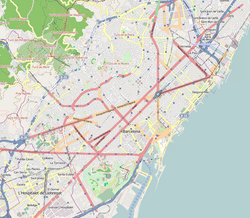Torrassa | |||||||||||||||||||||
|---|---|---|---|---|---|---|---|---|---|---|---|---|---|---|---|---|---|---|---|---|---|
 Line 1 platforms | |||||||||||||||||||||
| General information | |||||||||||||||||||||
| Location | L'Hospitalet de Llobregat | ||||||||||||||||||||
| Coordinates | 41°22′07″N2°06′58″E / 41.36861°N 2.11611°E | ||||||||||||||||||||
| System | Barcelona Metro rapid transit station | ||||||||||||||||||||
| Owned by | Transports Metropolitans de Barcelona | ||||||||||||||||||||
| Construction | |||||||||||||||||||||
| Structure type | Underground | ||||||||||||||||||||
| Other information | |||||||||||||||||||||
| Fare zone | 1 (ATM) | ||||||||||||||||||||
| History | |||||||||||||||||||||
| Opened | 1983 | ||||||||||||||||||||
| Services | |||||||||||||||||||||
| |||||||||||||||||||||
| |||||||||||||||||||||
Torrassa is a Barcelona Metro station, in the L'Hospitalet de Llobregat municipality of the Barcelona metropolitan area, and named after the nearby La Torrassa neighbourhood. The station is served by line L1, line L9 and line L10. [1] [2]
The station is located underneath the Avinguda Catalunya, between the carrer d'Almeria and carrer de Rosalía de Castro. There are two entrances, from Avinguda Torrent Gornal and Carrer d'Almeria, which serve a below ground ticket hall. The two 96-metre (315 ft) long side platforms are at a lower level. [2] [3]
The station was opened in 1983, at the time of the extension of line L1 from Santa Eulàlia station. It remained the terminus of the line until 1987, when line L1 was further extended to Avinguda Carrilet station. [2]
Future plans are for Torrassa station to a link to a new Rodalies de Catalunya commuter rail station between L'Hospitalet de Llobregat and Barcelona Sants stations. [4]



